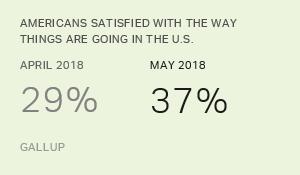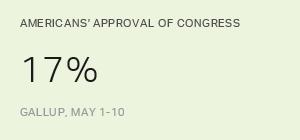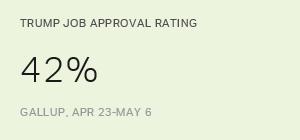Story Highlights
- Has not been a higher level of satisfaction since September 2005
- Satisfaction has risen among Republicans, independents
WASHINGTON, D.C. -- Thirty-seven percent of Americans are satisfied with the way things are going in the country today, up from 29% in April. Gallup has not measured a higher level of satisfaction since a 39% reading in late September 2005, although 37% were also satisfied right before the November 2016 election, and 36% were satisfied in February 2018 after the State of the Union address.
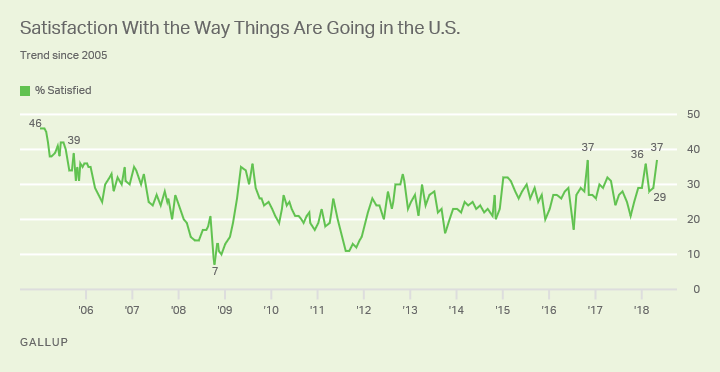
The latest results are based on a May 1-10 Gallup poll, which was conducted after North Korea announced it will end testing of nuclear weapons and engage in diplomatic talks with the U.S. The higher satisfaction recorded this month also followed the release of the April U.S. jobs report, showing unemployment at 3.9%, the lowest since 2000.
Satisfaction now exactly matches the historical average of 37% dating back to Gallup's initial measurement of this question in 1979. On an annual basis, the percentage satisfied has been below 30% each year since 2005, including 27% in 2017.
So far in 2018, an average of 32% of Americans have been satisfied, still below the historical average for the entire trend. Sub-30% ratings in January, March and April have offset the relatively high satisfaction this month (37%) and in February (36%). The February reading came after President Donald Trump's State of the Union address, in which he touted recently passed tax cuts and the country's economic progress.
Republicans, Independents More Satisfied
The rise in satisfaction this past month has been attributable to a large increase among independents (from 26% to 35%) and a smaller increase among Republicans (from 57% to 63%). Meanwhile, 14% of Democrats are satisfied, essentially unchanged from 13% readings the past three months, and similar to the 12% average for that group since Trump became president.
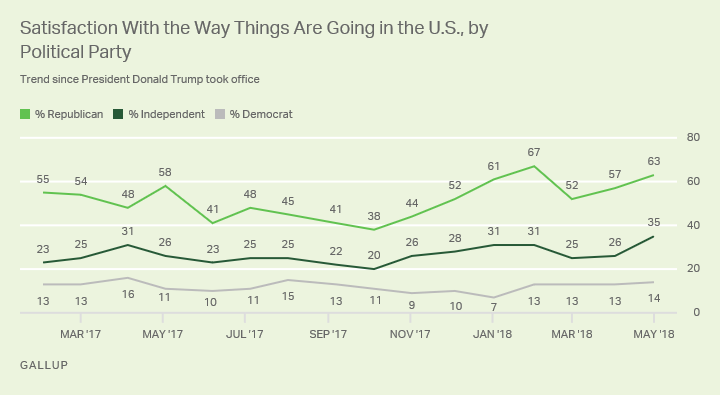
Republican satisfaction is slightly below where it was in February, when 67% were satisfied, before falling to 52% in March after the Parkland, Florida, school shooting incident.
Independents' satisfaction also dipped modestly in March, but is higher now (35%) than at the start of the year (31%).
Gallup has not measured higher satisfaction among independents since July 2005, when 37% were satisfied.
Implications
It has been nearly 13 years since Americans' satisfaction with the state of the nation was higher than it is today. Satisfaction began its downward trend in late 2005 during the second Iraq War and after Hurricane Katrina. A major economic recession, partisan gridlock and other factors helped keep satisfaction levels low in subsequent years.
Even so, the rise in satisfaction in May has only brought this measure to meet the historical average. It remains significantly below where it was in December 2000 (51%) -- the last time unemployment was as low as it is now.
If satisfaction remains where it is or increases, as opposed to falling back as it did after the increase in February this year, it could aid the Republican Party in the 2018 midterm elections. Going into November 2018, the GOP will try to avoid suffering heavy defeats like the Democratic Party experienced in Bill Clinton and Barack Obama's first terms as president.
Survey Methods
Results for this Gallup poll are based on telephone interviews conducted May 1-10, 2018, with a random sample of 1,024 adults, aged 18 and older, living in all 50 U.S. states and the District of Columbia. For results based on the total sample of national adults, the margin of sampling error is ±4 percentage points at the 95% confidence level. All reported margins of sampling error include computed design effects for weighting.
Each sample of national adults includes a minimum quota of 70% cellphone respondents and 30% landline respondents, with additional minimum quotas by time zone within region. Landline and cellular telephone numbers are selected using random-digit-dial methods.
View survey methodology, complete question responses and trends.
Learn more about how the Gallup Poll Social Series works.
